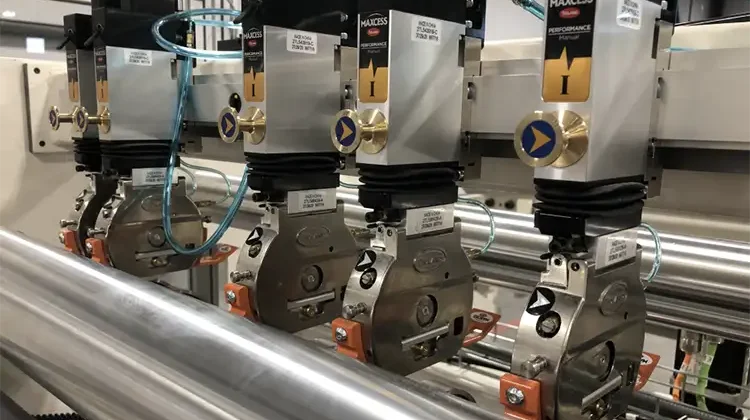
By Jay Roth, sales engineer, ELSNER Engineering Works, Inc.
During the COVID-19 pandemic, canister wipes are in hot demand. This firm has manufactured dozens of perforator rewinders used in manufacturing rolled canister wipes. With that demand, however, many new operators have been hired and there is more need to train for smooth production runs. Good tension is essential for consistent and efficient operation of a perforator rewinder. This article will look at this firm’s perforator-rewinder systems used primarily for coreless, nonwoven canister wipes production, explain the components and describe how each part helps control the web as it goes through the machine. The article also will break down each tension zone and share best practices of controlling the web tension.
Perforator rewinder overview
This firm’s ENR-Series of automatic perforator rewinders are used to convert nonwoven fabrics from master rolls into retail-product rolls. The machines are designed to convert the retail-product roll in different types of roll configurations. These configurations are coreless roll and coreless roll (log) segments. Roll (log) segments are achieved by an optional slitting unit. The modular-design machine can be equipped to produce the various roll configurations as required by the customer. The line consists of up to four integrated sections.
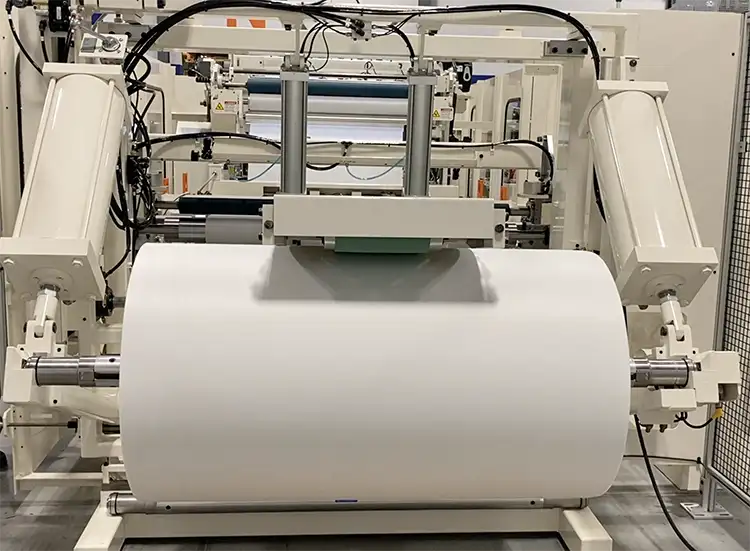
Section 1: Master Roll Unwinding. This unit can support up to a 50-in. diameter x 48-in.-wide master product roll (see Figure 1). The roll is mounted to the Unwind Stand frame by means of a pneumatic arbor that sits in a set of arbor journals. An off-the-floor roll lift is provided to lift the master roll off the floor into the journals. The material on the master roll is unwound by means of a pull-roll assembly and is assisted by a driven-belt assembly that lays on the outside diameter of the master roll. The web may be edge-guided or center-guided, both in automatic and manual modes. Tension is controlled by means of a dancer assembly.
Section 2: Plow Section is optional and is used to slit the master roll down the center and fold the two slit webs into various customer-driven fold configurations. The optional folding plows may be manually positioned or automatically positioned (option) across the web as needed. The Plow Section can be added onto the perforator-rewinder systems at any time.
Section 3: Rewinder Section consists of multiple assemblies to convert and rewind the rolls. The function of each of the sections is described below.
Section 3.1: The Perforator Assembly creates perforations in the material as it moves through the assembly. It consists of a rotating top-knife blade and a stationary bottom-knife blade. The stationary blade has notches in the cutting edge to create the specific perforation desired. A pull-roll assembly is provided just before the rotating knife blade. Perforation spacing may be infinitely adjusted from 4 to 12 in. via the HMI. The rotating perforator is controlled by means of a closed-loop motor.
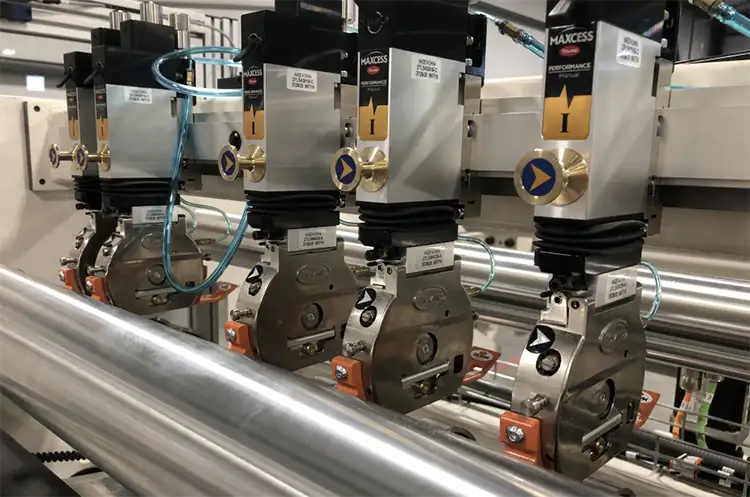
Section 3.2: The Shear Slitting Assembly consists of up to seven sets of shear slitters and rotating anvils (see Figure 2). The purpose of the slitters is to slice the web material from the master roll into multiple sections or “lanes.” If not required, individual slitters may be locked into the raised position and moved out of the way for different lane configurations.
Section 3.3: The Bowed Roller Assembly will spread the numerous lanes apart slightly before rewinding occurs. This is to prevent interweaving of the material lanes as they are being rewound on the rewind spindles. The bowed roller is independently driven and controlled via an HMI-entered value.
Section 3.4: The Rider Roller Assembly is a wide roller that lays against the product as it is being rewound on the winding spindles. The rider roller assists in winding and creates a denser rewound roll, if required.
Section 3.5: Turret and Spindle Assembly: The rewinding of the material is done on a driven spindle. There are four spindles mounted on a four-station turret assembly. The spindles have collapsible leaves that are expanded when winding begins, then collapse when the product rolls are taken off the spindles. The four stations of the turret: the Roll Start Station, the Roll Winding Station, the Roll Strip-Off Station and the Roll Ready Station. The Roll Start Station is where the material is introduced onto the spindle. The Roll Winding Station is where the roll finishes its winding process. The Roll Strip-Off station is where the finished rolls are removed from the spindle.
Section 3.6: Roll Starter Assembly engages a winding spindle at the Roll Start Station. The assembly consist of a series of belts that assist in guiding the leading edge of the product around the spindle. After initial winding has begun at the Roll Start Station, the Roll Starter Assembly retracts out of the way to continue winding.
Section 3.7: The Web Separator Assembly consists of a driven roller that is servo-actuated into a position that creates a nip between it and another driven roller (located on the Roll Starter Assembly), which causes a separation of the web or product to occur at its perforation.
There are two options for tails of the roll to be tied: Ultrasonic tail tie or glue closure.
Section 3.8: The Tail Control Assembly is a series of brushes/and or Ultrasonic Horn Assemblies that are used to control and wipe/pin the tail of the product against the outside diameter of the roll after web or product separation occurs.
Section 3.8.1: The purpose of the optional Glue Closure Assembly is to apply a small amount of glue to the end of the forming product roll to adhere the end of the product roll, or tail, to the product roll itself.
3.9: The Roll Strip-Off Assembly consists of two parts: A horizontal, servo-controlled linear actuator and a servo-controlled, vertical-stripping assembly that is mounted to its carriage. The purpose of this assembly is to remove the rewound product roll lanes from a winding spindle.
Section 3.10: The Discharge Conveyor Assembly is a belt conveyor that receives the rewound roll-product lanes as they are stripped off the winding spindles. The conveyor carries the finished rolls away from the machine at 90° from the main product flow through the machine.
Section 4: Reject Conveyor Section (Optional). The section ensures that bad product is discharged off the main line before it gets to the downstream equipment.
Tension Control Zone 1: Unwind dancer
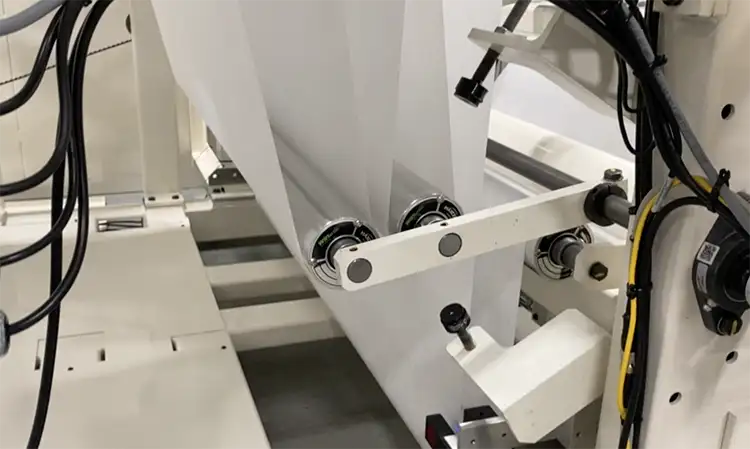
This firm’s initial perforator rewinder uses the position of the unwind dancer assembly to control or trim the speed of the belt drive on the unwind stand (see Figure 3). The position of the counter-balance weight on the dancer-arm assembly controls the amount of tension in the web. On the latest model, this firm has replaced the manually positioned weight with a pneumatic transducer, allowing control from the HMI at the front of the machine. The higher the pressure, the lower the tension and conversely, the lower the pressure, the higher the tension. If an increase in web tension is desired, move the weight toward the pivot point of the dancer, making the dancer easier to lift. The dancer pressure is saved in the HMI recipe for a given product.
Tension Control Zone 2: Perforator pull roll
The pull roll on the initial system has three operating positions. The first is fully “up” and locked away from contact with the driven steel roller. With the pull roll “up,” it allows for other tension-control mechanisms to take charge. The second position is referred to as the “float” position, which leaves the pull roll to lay on the lower driven roller just by its own weight, providing some isolation of tension between the unwind and rewind sections but allowing for some slip during the run.
The final position is “locked down.” This means that the locking pin on the handle is fully engaged with the provided hole in the perforator frame. This provides fully isolated tension zones and is used for more tension-critical materials. A product that has a lot of machine-direction (MD) elasticity might need this to keep from stretching the web when pulling from the rewind back to the unwind. Having tension controlled over a shorter distance gives better control in this situation.
On the newer model, pneumatic cylinders are used in place of the locking mechanism. Again, this allows full control without leaving the operator station.
Tension Control Zone 3: Rider roll
The rider roll on the ENR-Series can be used to aid in tension control and to impart pressure on the forming roll. Slight speed adjustments of the rider roll versus web speed help make a tighter or looser roll. Rider-roll speed typically is set to run fractionally above web speed. Controlling the positioning of the rider roll is another tool for good tension control.
All ENR rewinders also are equipped with an option to lift the rider roll off of the forming roll. Lifting the rider roll away from the forming roll passes complete winding tension control to the rewind spindles. Choosing to leave the rider roll against the forming roll is done to create a tighter/denser wind. The rider-roll settings all are within the HMI’s recipe screen, so unique settings for each product code can be saved and loaded repeatably.
Tension Control Zone 4: Spindle torque
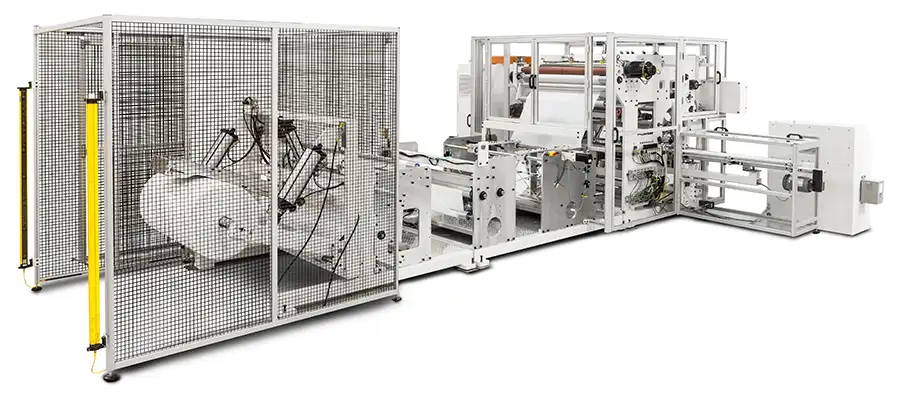
The final tool to control web and roll tension is the torque imparted by the winding spindles. All ENR rewinders are equipped with an electromagnetic clutch that allows for precise and repeatable adjustments. This torque setting is adjustable for each spindle and determines how easily the spindle drive is allowed to “slip” during the winding process. A higher torque setting results in less slip and a tighter finished roll. Low torque settings allow more slip and usually result in a loosely wound roll. Of course, proper care and setup of the machine and keeping tabs on all settings are critical to efficient use of all perforator rewinders. Proper blade selection and material quality always are a high priority.
Conclusion
If tension control is optimal and the machine is running at optimal speeds, this firm’s series of perforator rewinders (see Figure 4) produce rolls at web speeds up to 700 fpm and a cycle rate up to 22 indexes/min. Roll throughput will vary depending on roll length. Avoiding troubleshooting issues such as telescoping rolls, baggy rolls and web breakouts relies on proper tension control. Being in control of web tension is how to ensure highest efficiencies.
Jay Roth, sales engineer for ELSNER Engineering Works, Inc. (Hanover, PA), has 30 years of experience at ELSNER having served in the machine shop, as an mechanical engineer and now as a consultative director of sales. He can be reached at 717-637-5991, fax: 717-633-7100, email: eew@elsnereng.com, www.elsnereng.com.

